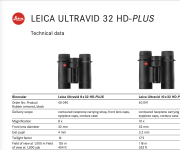In looking at various manufacturer specs, the stated FOV in meters and feet seem to (generally) not actually agree.
The stated FOV in meters is generally larger than the state FOV in feet (if a manufacturer provides the spec in both units).
I saw one example where they FOV was stated at 118m (which, should be about 387 feet) but instead they listed it as 354 feet.
33' is a not inconsiderable difference. Seems like most of the industry is calling 1m = 3'; though I've seen one use around 2.9';
the actual conversion should be 1m = 3.281' - no?
This makes me question numbers I've seen on 3rd party sites (say B&H) that have stats for nearly every bino currently on sale.
I know that the best policy is to do direct personal A/B comparison - but when there's not many samples one can lay hands on directly
using a site with specs is (or I had hoped would be) invaluable as a starting point of comparison/information.
The stated FOV in meters is generally larger than the state FOV in feet (if a manufacturer provides the spec in both units).
I saw one example where they FOV was stated at 118m (which, should be about 387 feet) but instead they listed it as 354 feet.
33' is a not inconsiderable difference. Seems like most of the industry is calling 1m = 3'; though I've seen one use around 2.9';
the actual conversion should be 1m = 3.281' - no?
This makes me question numbers I've seen on 3rd party sites (say B&H) that have stats for nearly every bino currently on sale.
I know that the best policy is to do direct personal A/B comparison - but when there's not many samples one can lay hands on directly
using a site with specs is (or I had hoped would be) invaluable as a starting point of comparison/information.






